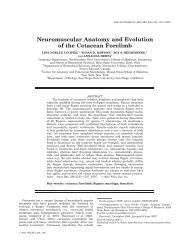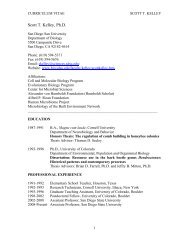Comparative anatomy and evolution of the odontocete forelimb
Comparative anatomy and evolution of the odontocete forelimb
Comparative anatomy and evolution of the odontocete forelimb
Create successful ePaper yourself
Turn your PDF publications into a flip-book with our unique Google optimized e-Paper software.
2 MARINE MAMMAL SCIENCE, VOL. **, NO. **, 2009<br />
b, c; Klima 1985; Watson et al. 1994; Calzada <strong>and</strong> Aguilar 1996; Sedmera et al.<br />
1997; Dawson 2003; Cooper et al. 2007a, b). The scapula <strong>of</strong> <strong>odontocete</strong>s is almost<br />
completely flat, bears a low scapular spine, <strong>and</strong> displays a supraspinous fossa that is<br />
reduced in area relative to terrestrial artiodactyls (Benke 1993). A shortening <strong>and</strong><br />
flattening <strong>of</strong> <strong>the</strong> humerus, radius, <strong>and</strong> ulna is also observed in <strong>odontocete</strong>s (Howell<br />
1930a, Benke 1993, Dawson 2003). Most <strong>odontocete</strong>s possess five carpals, however,<br />
in some taxa such as in Phocoena phocoena <strong>and</strong> Tursiops truncatus <strong>the</strong>re is a sixth carpal,<br />
<strong>the</strong> accessory (Watson et al. 1994, Ortega-Ortiz <strong>and</strong> Villa-Ramirez 2000). Based on<br />
previous literature, in all species <strong>the</strong> bones <strong>of</strong> <strong>the</strong> manus show a decrease in size <strong>and</strong> an<br />
increase in number <strong>of</strong> phalanges (hyperphalangy); two species also show an increase<br />
in number <strong>of</strong> digits (polydactyly) (Kukenthal 1893, Pilleri et al. 1976c, Watson et al.<br />
1994, Sedmera et al. 1997, Ortega-Ortiz <strong>and</strong> Villa-Ramirez 2000, Bejder <strong>and</strong> Hall<br />
2002, Cooper <strong>and</strong> Dawson 2009).<br />
The myology <strong>of</strong> <strong>the</strong> <strong>odontocete</strong> <strong>forelimb</strong> has also been previously studied (Howell<br />
1930a; Pilleri et al. 1976; Smith et al. 1976; Strickler 1978, 1980; Cooper et al.<br />
2007b). Stability <strong>and</strong> maneuverability requirements led to various modifications <strong>of</strong><br />
<strong>the</strong> muscles <strong>of</strong> <strong>the</strong> shoulder girdle <strong>and</strong> <strong>the</strong> manus. The shoulder girdle <strong>of</strong> physeterids<br />
<strong>and</strong> ziphiids possess a subscapularis muscle that is divided into different<br />
fiber columns separated by tendinous sheaths (Cooper 2004). Compared to delphinoids<br />
(monodontids, phocoenids, <strong>and</strong> delphinids), <strong>the</strong> shoulder <strong>of</strong> <strong>the</strong> La Plata river<br />
dolphin, Pontoporia blainvillei, exhibits a greater degree <strong>of</strong> muscle differentiation<br />
(specialization <strong>of</strong> muscular structures <strong>and</strong> diversity <strong>of</strong> muscular fiber architecture),<br />
<strong>and</strong> an increase in volume (Strickler 1978). The deltoid muscle in Monodon monoceros<br />
is characterized by being very large <strong>and</strong> showing a strong aponeurosis at <strong>the</strong><br />
origin <strong>and</strong> a thin division overlying <strong>the</strong> main muscle mass separable only along its<br />
cranial border (Howell 1930a). The extensors <strong>and</strong> flexors are conserved within basal<br />
<strong>odontocete</strong>s (i.e., physeterids <strong>and</strong> ziphiids), but are reduced or completely lost within<br />
later diverging species (e.g., delphinids) (Cooper et al. 2007b). In Delphinus delphis for<br />
example, <strong>the</strong> muscles responsible for flipper extension (Pilleri et al. 1976) <strong>and</strong> flexion<br />
(Cooper et al. 2007b) are poorly developed.<br />
Flippers are <strong>of</strong> prime importance in total hydrodynamics (Felts 1966), functioning<br />
as hydr<strong>of</strong>oils for controlling stability, minimizing drag, <strong>and</strong> effecting forces in<br />
roll, pitch, <strong>and</strong> yaw directions (Edel <strong>and</strong> Winn 1978). The flipper is adjustable at<br />
<strong>the</strong> shoulder through extension <strong>and</strong> flexion in <strong>the</strong> horizontal plane, abduction <strong>and</strong><br />
adduction in <strong>the</strong> vertical plane, <strong>and</strong> rotation around its own axis (Felts 1966). The<br />
diversity <strong>of</strong> morphological shapes <strong>of</strong> <strong>the</strong> flipper has been related to swimming speed<br />
<strong>and</strong> propulsive efficiency in whales <strong>and</strong> dolphins (Fish 1998, Fish <strong>and</strong> Rohr 1999,<br />
Woodward et al. 2006). Functional analyses have shown that <strong>the</strong> relationship between<br />
lift <strong>and</strong> drag depends on <strong>the</strong> shape <strong>of</strong> <strong>the</strong> appendage (Hertel 1966, Alex<strong>and</strong>er<br />
1970). Previous studies have identified two flipper morphologies; fast-swimming<br />
cetaceans have an elongated flipper with a thin trailing edge capable <strong>of</strong> generating<br />
lift; while those cetaceans requiring maneuverability at slow speeds possess a broad<br />
or spatulate-shaped flipper (Benke 1993, Cooper 2004, Woodward et al. 2006). Paddling<br />
is associated with slow swimming <strong>and</strong> precise maneuverability (Webb 1984)<br />
<strong>and</strong> generally is used in surface swimming (Fish 1992). In ei<strong>the</strong>r case, <strong>the</strong> flipper<br />
should have a broad surface with a relatively thin border, to swim through <strong>the</strong> water<br />
with <strong>the</strong> least amount <strong>of</strong> resistance (Howell 1930b).<br />
This study provides a comparative analysis <strong>of</strong> <strong>the</strong> structure <strong>of</strong> eight muscles <strong>of</strong> <strong>the</strong><br />
shoulder girdle responsible for flipper movement in a large sample <strong>of</strong> <strong>odontocete</strong>s.<br />
We optimize flipper osteological <strong>and</strong> external shape characters onto a composite




